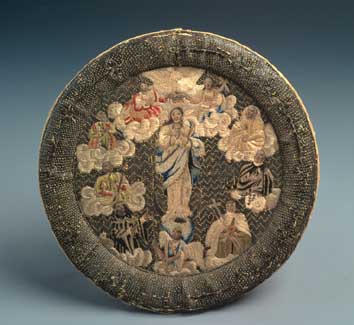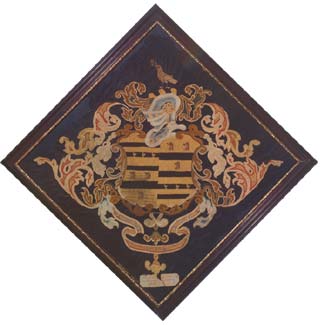|
Women and
Sewing
These two pieces of embroidery show symbols or images important
to the woman who made them. As the hatchment by Hannah Babcock reveals,
fancy sewing was considered an essential part of the education of
a well-to-do young woman. Miss Babcock attended a finishing school
in Boston to learn skills desirable in a wife. The nun who created
the insignia also learned fancy embroidery, but put her skills to
use in the service of religion.
|
|
|
|
|
Nun's Emblem
Franz Mayer Collection
|
Hatchment
Bayou Bend Collection
|
Silk and silver
thread embroidery
18th century
New Spain
view large image
(73K, 27 sec on 28K)
|
|
A Nun's Insignia
This
insignia portrays the Immaculate Conception crowned by the Trinity.
Clockwise from the upper right, the saints surrounding Mary are
Anne, her mother; Francis Xavier; Gertrude; the Archangel Gabriel
at her feet; Francis, Joseph, and Mary's father Joachim.
|
A Hatchment
A coat of arms is in the center here, with a helmet above and
a foliate design on the sides. Inscribed on the ribbon underneath
the arms are the names Howe and Babcock. Since most American families
did not have coats of arms, they frequently adopted a coat of
arms related to their family name.
|
Use
In
the Middle Ages, nuns traditionally wore images of the saints
to whom they prayed. This insignia was worn by a Conceptionist
nun on the chest or shoulder of her white habit. Conceptionists
were a branch of the Order of St. Clare.
|
Use
A
hatchment usually presents the coat of arms in a diamond or lozenge
shape. The word hatchment comes from the word "achievement."
|
Sewing
The
nun who sewed this insignia demonstrates skilled knowledge of
embroidery. She probably learned sewing at home, before entering
the convent. Once cloistered, nuns performed useful work which
may have included sewing.
|
Sewing
Hannah
Babcock, from Milton, Massachusetts, attended a boarding finishing
school in Boston. As part of her education, she learned fancy
sewing and embroidered this hatchment. She also would have learned
music and drawing.
|
Technique
& Materials
The
figures of Mary and the saints around her are embroidered with
loose silk thread using a stitch that forms a pattern of broken
lines. A thick, padded border covered with silk and silver thread
embroidery circles the scene.
|
Technique
& Materials
Hannah
Babcock used silk embroidery thread on a black satin background.
John and Samuel Gore, heraldic painters in Boston, probably transferred
this design onto the fabric, adding some elements.
|


